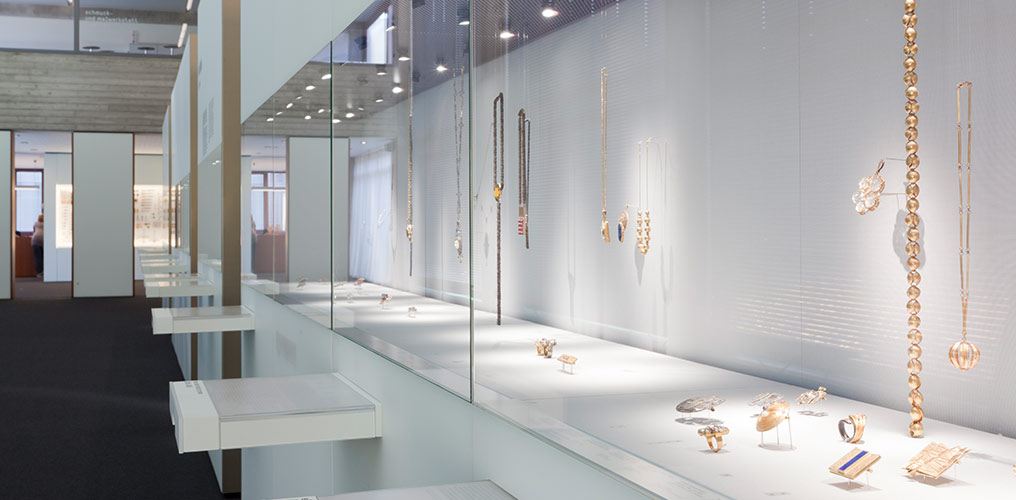The Reuchlinhaus
Architecture in the International Style
The Reuchlinhaus is a masterwork of post-war German architecture. Built in 1957-61 as the municipal cultural centre, it presents itself in the clean lines of the International Style. Its lobby and heart is the square entrance hall, a foyer flooded with light and offering a view of luxuriant greenery through its huge panoramic windows. The focal point of the upper foyer is a circular opening for the free-standing spiral staircase leading to the ground floor. The lobby is the start and recurrent meeting-point for guided tours.
An Ark for Culture
After total war-time destruction on February 23, 1945, the cultural institutions in Pforzheim with their greatly decimated holdings eventually found, as in a Noah’s Ark, a new home in the Reuchlinhaus for the municipal archives, museums and the Kunstverein with its rich tradition. It takes its name in honour of the city’s most famous son, the scholar, writer and lawyer Johannes Reuchlin (1455-1522).
The Architect
Manfred Lehmbruck (1913-1993), who was born in Paris and grew up in Zürich and Berlin, was a son of the famous sculptor Wilhelm Lehmbruck. In the 1930s, Mies van der Rohe arranged for Lehmbruck to work at the Paris office of Auguste Perret, France’s leading architect, where he found the model for his spectacular spiral staircase. In 1942, he took his degree with a doctoral thesis on ›Museum Architecture of the Future‹. After internment and active service, Lehmbruck opened an office for industrial architecture in Stuttgart. His breakthrough came in 1953, when he won the Pforzheim competition.
More about the history of the Reuchlinhaus
In 1961, the Reuchlinhaus was inaugurated as a municipal cultural centre. The building in the formal language of the »International Style« united an art gallery, library, museum and ballroom in an ensemble of four cubic structures. Based on designs by Manfred Lehmbruck (1913-93), son of the sculptor Wilhelm Lehmbruck, a building was erected in the bombed-out city centre of Pforzheim whose concept was described by the architect himself as follows: »Painting, sculpture, arts and crafts, the written and spoken word and chamber music are to find their home here. For its completion, it was given the name of the city's most famous son, the humanist scholar, writer and jurist Johannes Reuchlin (1455-1522)«.
It is the first project in which Lehmbruck put his scientific research on museum buildings into practice and helped him achieve his architectural breakthrough. The architect designed each structure in relation to what was to be presented inside: He clad the building of the Museum of Local History in sandstone from the Black Forest, formed the outer skin of the Jewellery Museum out of aluminium and glass, the exhibition hall of the Kunstverein was given a steel and glass construction, the municipal library a glazed concrete building. The heart of the Reuchlinhaus is the entrance hall. From here, one can let one's gaze wander into the surrounding city garden and connect culture and nature. The cantilevered steel spiral staircase leads to the lower foyer with lecture hall, gallery to the courtyard and the courtyard itself with water basin and cascade.
After Manfred Lehmbruck lost his father as a child at an early age, it was Ludwig Mies van der Rohe who awakened his interest in modern architecture. Clearly alluding to the Barcelona Pavilion, Lehmbruck created a monument to it with the Reuchlinhaus. Through Mies' mediation, the young architect also assisted Auguste Perret in Paris for a time, where he found the source of inspiration for his spiral staircase.
Over time, the use of the Reuchlinhaus changed. In the 1980s, the local history museum moved into its own premises, and in the 1990s the municipal library moved out. Since March 2006, after the sensitive conversion of these two wings of the listed building by the architectural firm HG Merz, the Pforzheim Jewellery Museum has been able to present its top-class collection in a much more spacious setting. In the »old« Jewellery Museum, historical pieces from antiquity to historicism are on display. Here, pocket watches from the collection of the Pforzheim watchmaker Philipp Weber have also been added as a permanent loan from the Sparkasse Pforzheim Calw. The former library houses jewellery art of the 20th and 21st centuries, from Art Nouveau to the present day, as well as space for special exhibitions. In the former local history museum, visitors can now find ethnographic jewellery from the Eva and Peter Herion collection.





